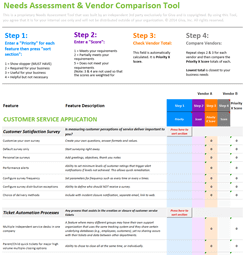Identifying and Closing Customer Service Gaps: Tools and Techniques for Enhanced Business Success
Businesses today know that providing exceptional customer service is a must for attracting and retaining customers. However, even the best companies can encounter customer service gaps that hinder their performance. Identifying and closing those gaps is critical for customer expectations to be met and exceeded. Customers may give you one chance to redeem yourself, and you need to make it count!
This article explores the different types of customer service gaps, their impacts, and strategies to effectively address them before they become an issue.

What Are Customer Service Gaps?
Customer service gaps refer to the discrepancies between what customers expect from a service and what they actually receive.
These gaps can occur at various stages of the service delivery process. They can be from initial customer interactions, like asking where a product might be and your employee not knowing, to the final resolution of issues, like refusing a refund for a product that arrived damaged.
Once identified, businesses can implement targeted strategies that work for both them and the customer.
Why It's Important to Identify Customer Service Gaps
- Enhances Customer Experience: By addressing service gaps, businesses can ensure that customers receive a consistent and high-quality experience.
- Boosts Customer Retention and Drives Revenue Growth: Customer satisfaction increases revenue because happy consumers are more likely to make repeat purchases and refer business to others.
- Identifies Training Needs: Recognizing where service falls short helps identify areas where staff may need additional training or resources. It is important that businesses acknowledge when there are gaps. Being in denial only amplifies the damage done by these issues.
- Improves Service Efficiency: Addressing gaps can streamline service processes. This can reduce the time and effort required to resolve customer issues.
- Enhances Competitive Advantage: Businesses that effectively address customer service gaps can differentiate themselves from competitors. This in turn can help attract and retain more customers.
- Promotes Continuous Improvement: Regularly identifying and addressing service gaps builds a culture of continuous improvement. This aids the business in adapting to changing customer needs and service expectations.
Tools and Techniques to Identify Gaps
Effectively identifying customer service gaps can require a combination of tools and techniques. Here are some of the most effective methods:
-
Customer Feedback Surveys
Directly ask customers about their experiences and areas where they feel service could be improved. Use online surveys, comment cards, or follow-up emails to gather this information.
-
Mystery Shopping
Hire mystery shoppers to evaluate your service from a customer's perspective. This can provide unbiased insights into the actual service experience.
-
Service Quality Audits
Regularly audit your service processes to make sure they meet established standards. Identify any deviations that could lead to service gaps.
-
Data Analysis
Analyze customer service data, such as call center logs, complaint records, and customer reviews, to identify patterns and recurring issues.
-
Employee Feedback
Gather feedback from frontline employees who interact with customers daily. They can provide valuable insights into potential service gaps and areas for improvement.
-
Social Media Monitoring
Monitor social media channels for customer comments and reviews. This can help identify service issues that may not be reported through traditional feedback channels.
To explore more strategies on improving customer service, check out these resources:
- Customer Service Levels: Definitions, Importance and 20 Creative Improvement Strategies
- 15 Top Ways to Elevate Your Customer Service Strategy
- 15 Cutting-Edge Ideas for Improving Customer Service
How to Apply the SERVQUAL Model at Your Business
The SERVQUAL model helps measure and improve service quality by comparing customer expectations with their actual experiences. Here's how to apply it:
-
Define SERVQUAL Dimensions for Your Business (overarching components for your business model)
- Tangibles: Physical aspects like facilities, equipment, and staff appearance
- Reliability: Consistent and accurate service delivery
- Responsiveness: Willingness and ability to help customers quickly
- Assurance: Employees' knowledge, courtesy, and ability to instill trust
- Empathy: Caring, individualized attention to customers
-
Develop SERVQUAL Surveys
- Create Surveys: Design surveys to rate customer expectations and perceptions across the SERVQUAL dimensions described above.
- Distribute Surveys: Use channels like email, website pop-ups, and in-store kiosks.
-
Collect and Analyze Data
- Analyze Gaps: Once you have collected survey results, compare the experiences against your business model noted in the first subsection above.
- Identify Patterns: Look for recurring issues needing improvement. Are you consistently receiving feedback about employees not knowing where specific products are within your store? One-off issues are concerning, but pattern-issues can indicate areas of greater concern.
-
Develop Action Plans
- Create Solutions: Develop strategies such as staff training and process improvements.
- Assign Responsibilities: Designate team members to implement solutions. For example, create a team lead who oversees implemented changes and ensures consistency.
-
Monitor and Review
- Regular Assessments: Conduct SERVQUAL assessments regularly to track progress. This is not a one and done process!
- Adjust Strategies: Modify strategies based on feedback and evolving customer expectations. Feedback can change regularly based on a variety of feedback - employee turnover, new products and updated policies, just to name a few.
Common Customer Service Gaps
Here are some of the most frequent gaps businesses encounter, along with their causes, impacts, and solutions:
-
Knowledge Gap
Definition: Difference between customer expectations and staff knowledge
Causes: Inadequate training, outdated information
Impact: Customers feel misinformed or unsupported, leading to frustration and mistrust
Solution: Invest in continuous training and regularly update the corporate knowledge base
Example: An employee working a call center for a telecom company provides misleading information about mobile plan features. The customer finds out after receiving their first bill, and is understandably upset.
-
Policy Gap
Definition: Discrepancy between customer expectations and company policies
Causes: Rigid, outdated, or unfriendly policies
Impact: Customers perceive the company as inflexible or unaccommodating, resulting in dissatisfaction
Solution: Regularly review and update policies based on customer feedback and market trends
Example: An airline changes its policies for flight refunds to flight credits. While this may work for some, receiving money back for a canceled booking would likely be the more ideal solution.
-
Delivery Gap
Definition: Difference between service standards and actual service delivered
Causes: Inconsistent service, lack of resources, inadequate performance management
Impact: Customers experience varying service quality, leading to confusion and dissatisfaction
Solution: Standardize service processes, implement quality control measures, and ensure adequate resource allocation
Example: You visit a particular restaurant 3-4 times a month for lunch. You order the same garden salad, but it's prepared differently each time. While it may not be a negative thing, the inconsistency can be off-putting.
-
Communication Gap
Definition: Gap between what is promised to customers and what is actually delivered
Causes: Over-promising in marketing, miscommunication between departments, lack of clarity in service promises
Impact: Customers feel deceived or let down, resulting in a loss of trust and loyalty
Solution: Set realistic expectations in marketing materials, improve internal communication, and align promises with actual service delivery
Example: A car dealership runs a promotion offering free mats with each new vehicle purchase through online and TV ads. However, the fine print notes that this only applies to vehicle purchases over $30K. While it is in the fine print, the bold marketing can be perceived as "misleading" to the average consumer who buys a vehicle worth less.
-
Perception Gap
Definition: The difference between the service quality perceived by customers and the actual service delivered
Causes: Unmerited bad reviews, public relations issues, miscommunication
Impact: Customers may distrust the company, the business reputation may be harmed, and customer retention may decline
Solution: Be proactive in your communication and manage your online reputation. Responding to Google reviews can improve transparency and show that you care about your customers' concerns.
Example: A restaurant receives a negative review about long wait times due to an unusually busy day. Management addresses the review publicly, explains that the kitchen was short-staffed, and offers to connect with the customer directly to provide a discount for their next visit.
Future Trends and Technologies to Address Customer Service Gaps
As customer expectations evolve, businesses must stay ahead by adopting emerging trends and innovative technologies to address service gaps. Here are the five top trends and technologies to be aware of:
-
Personalization
Trend: Customers expect personalized experiences tailored to their individual needs and preferences.
Technology: Data analytics and AI algorithms help businesses customize interactions and recommendations based on a variety of metrics and patterns (i.e. purchasing habits).
-
Omnichannel Support
Trend: Providing seamless customer service across multiple channels ensures customers can reach support through their preferred method.
Technology: Integrated customer support platforms manage interactions across phone, email, chat, and social media. Remember, 9-5 customer service through a dedicated phone line is no longer ideal. Consider around the clock service, even if staffed by a chatbot after regular business hours.
-
AI and Machine Learning
Trend: Automating routine inquiries and providing instant support enhances efficiency.
Technology: AI-powered chatbots and virtual assistants handle common issues, while machine learning algorithms predict customer needs.
-
Customer Relationship Management (CRM) Systems
Trend: Integrating customer data from various sources provides a complete view and enables personalized service.
Technology: Modern CRM systems track and manage many if not all facets of customer interactions, reducing service gaps and improving overall inquiry resolution.
-
Proactive Customer Service
Trend: Addressing potential issues before they arise improves customer satisfaction.
Technology: Advanced analytics monitor customer behavior and predict needs, enabling proactive support. Though this does not need to be a completely automatic process.
For example, if you receive notice of a faulty product from one customer and are able to resolve the issue, it is best to prepare all customer service staff with a bulletin. This equips them ahead of time in the case that the issue becomes more widespread.
Other Resources Discussing Customer Service Gaps
The following is a list of other beneficial resources on this topic:
-
Books:
- Zap the Gaps! Target Higher Performance and Achieve It! by Kenneth H. Blanchard, Dana Gaines Robinson, and James C. Robinson
- Communication Gaps and How to Close Them by Naomi Karten
- Templates:
The Bottom Line: Closing Customer Service Gaps for Success
Identifying and closing customer service gaps is an essential element in maintaining customer satisfaction and loyalty. By understanding common gaps, using tools like the SERVQUAL model, and adopting new trends and technologies, especially those in the AI field, businesses can enhance service quality and reduce the space between their service gaps.
Giva Can Help Further Streamline Your Customer Service Processes
Giva's Customer Service Software can bring your organization these features and benefits:
- AI Copilot ticket summaries and re-write capabilities
- Auto close rules and workflows
- Parent/child tickets for long term projects
- Custom ticket forms capture additional necessary fields
- CC customers and assignees to send notifications to multiple people involved with issues
- Service Level Agreements to target respond/resolve times, measure goals and deliver consistent service
- Integrated knowledge base
Let Giva help keep those customer service gaps closed! Book a free Giva demo to see our solutions in action, or start your own free, 30-day trial today!





